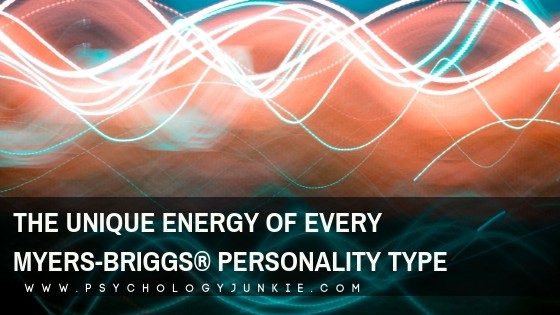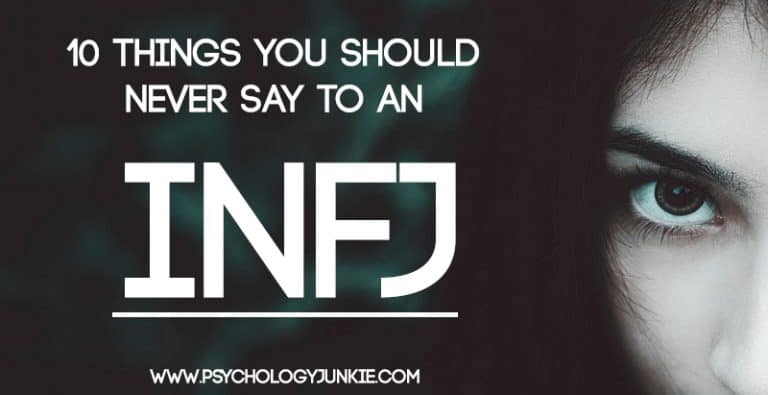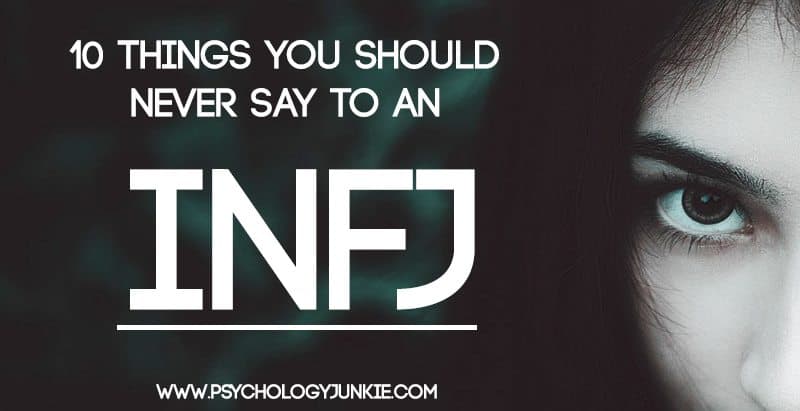The Unique Energy of Every Myers-Briggs® Personality Type
Have you ever noticed how different people exude different types of energy? Some individuals appear open and ready for anything, while others have a commanding, dominating aura. Today we’re going to take a look at the different energy styles of each of the 16 Myers-Briggs types. The background research for my article comes from the work of leading type theorist Linda Berens, Ph.D., She founded the Temperament Research Institute and has discovered numerous links between interaction styles and personality type. You can find out more about Linda Berens (and take one of her certification programs) here.
Not sure what your personality type is? Take our new personality questionnaire!

This article contains affiliate links. I only recommend books I truly believe in.
Want to learn more about these personality types and interaction styles?
Check out Linda Berens’s books:
Understanding Yourself and Others – An Introduction to Interaction Styles
Understanding Yourself and Others: An Introduction to the Four Temperaments
Interaction Essentials: 3 Proven Strategies to Remove Communication Barriers
The Unique Energy of Every Myers-Briggs® Personality Type
INFJs, INTJs, ISTJs, and ISTPs – Focused Energy
There’s a very concentrated, observant energy surrounding these four personality types. Their minds always appear to be zoomed-in on something that only they can see. They calculate or envision the most likely course something will take and plan accordingly. They think situations and plans out well in advance and work carefully to achieve the desired results. They help to anticipate or circumvent problems and avoid wasted work or energy. These types tend to have a quiet, analytical demeanor and a deep need for alone time. They dislike a lot of noise, bright lights, or chaos in their environment (ISTPs have more tolerance for it but don’t prefer it). These four types also need a lot of personal space and tend to be bothered by individuals who are overly touchy or overbearing physically. They explain things in detail, hate to be rushed, and tend to be brief but assuring. Their focus is primarily on the goal or directive, although the nature of those goals or directives can be different depending on the type. People of this interaction style tend to dislike small talk and interruptions.
Summing Up Focused Energy Types:
- They have an urgent need to anticipate and foresee
- They are usually strategically minded
- They want to see steady, methodical action in pursuit of their goals
- They are process-oriented
- They tend to appear quiet, intense, and calm
- They have a gift for conceptualizing an end result
- They often create milestones or benchmarks
- They focus more on the internal world than the external world
- They need a lot of time to reflect
- They are comfortable working silently alongside people
- They think before commenting or acting
- They get frustrated by lack of a clear position or structure
- They are often certain that they are right
- Under pressure, they may be seen as bossy
- They focus on moving forward
Unique Differences and Skills Among These Types:
INFJs – Skill in foresight. These types have a gift for predicting and strategizing, foreseeing specific outcomes, and how to attain them. They are typically the warmest of these four personality types, focusing on developing and guiding individuals toward their potential. They help people stay on track by encouraging them, counseling them, and seeing and promoting their strengths. Linda Berens calls these types the “Foreseer Developers.”
Fictional examples of INFJ types: Remus Lupin (“Harry Potter”), Atticus Finch (“To Kill A Mockingbird”), Plutarch Heavensbee (“The Hunger Games”), Louise Banks (“Arrival”).
INTJs – Skill in strategy. These types conceive new ways of thinking about things and can direct others to make progress in turn. They are insightful and original, often seeing underlying meanings or patterns that bypass other types. They maximize efficiency and are often called upon when a complex, long-range objective needs to be achieved and planned out. Linda Berens calls these types the “Conceptualizer Directors.”
Fictional examples of INTJ types: Thranduil (“The Hobbit”), Elrond (“The Lord of the Rings”), Fitzwilliam Darcy (“Pride and Prejudice”), Amy Dunne (“Gone Girl”).
ISTJs – Skill in logistics. These types have a knack for creating detailed, sequential plans so that a goal can be achieved in an efficient, timely manner. They are good at organizing people, delegating, and leading in a calm, no-nonsense way. They foresee potential problems and focus their energy on avoiding negative effects. Their well-laid out plans and their quiet yet confident nature inspires trust in people. Linda Berens calls these types the “Planner Inspectors.”
Fictional examples of ISTJ types: Bill Tench (“Mindhunter”), John Bates (“Downton Abbey”), Eddard Stark (“Game of Thrones”), Dr. Alan Grant (“Jurassic Park”).
ISTPs – Skill in tactics. These are the people you need in an immediate crisis when a quick, smart solution is essential. They can solve problems rapidly without getting panicky. They use their focused energy to find resources, tools, and materials to circumvent problems and improve situations. Linda Berens calls these types the “Analyzer Operators.”
Fictional examples of ISTP types: Jason Bourne (“The Bourne Identity”), John Wick, Natasha Romanoff “Black Widow”, Geralt of Rivera “The Witcher.
Read These Next:
Here’s Why INFJs and INTJs Seem “Intense”
10 Things You’ll Relate to if You’re an ISTJ
INFPs, ISFPs, INTPs, ISFJs – Open Energy
These four personality types have an easy-going, insightful energy about them. They appear to be absorbing more and more data, remaining open for as long as possible. They believe that the more information they integrate the more likely they will be to get the best result. These types like a calm environment and hate to be rushed or interrupted. They need time for reflection and appreciate being asked for their opinion about things. They appreciate people who let them finish their sentences and who practice active listening. They prefer a gentle, thoughtful approach in all their conversations.
Summing Up Open Energy Types:
- They are more interested in the internal world than the external world
- They need reflection time before responding
- They tend to be patient and thoughtful
- They get irritated by a lot of deadlines
- They have a strong need to integrate information and see how everything fits together
- They hate disharmony of ideas, people, or information
- They look for the best result possible, even if that takes extra time
- They often seem unassuming and quiet
- Producing high-quality results is their aim
- Want a fair amount of control over their projects or initiatives and may struggle to delegate
- They enjoy inspiring people
- They tend to dislike being told what to do
- They may seem indecisive
- They are more likely to give information in order to elicit an action, rather than to direct others in a straightforward way
Unique Differences and Skills Among These Types:
INFPs – Skill in clarifying values. People of this personality type take individuals and organizations to the heart of who they are and what they stand for. They are often the ethical backbone of an organization or family, unifying and harmonizing divergent values and respecting individuality. INFPs keep people focused on what really matters in the long run. They are gifted at guiding others with gentle affirmation, imagination, and encouragement. Linda Berens calls these types the “Harmonizer Clarifiers.”
Fictional examples of INFP personality types: Belle (“Beauty and the Beast”), Newt Scamander (“Fantastic Beasts and Where to Find Them”), Frodo Baggins (“The Lord of the Rings”), Romeo Montague (“Romeo and Juliet”)
ISFPs – Skill in creation. People of this personality type are introspective and creative. They want to integrate resources, information, and materials into a composition that means something to them. They are creators of everything from music to food, stories to artwork, and more. They need freedom and variety and aim to make an impact by integrating values and perspectives from a variety of different worlds. They have a colorful yet tranquil style. Linda Berens calls these types the “Composer Producers.”
Fictional examples of ISFP personality types: Claire Fraser (“Outlander”), Cinna (“The Hunger Games”), Jon Snow (“Game of Thrones”), Rose Dewitt Bukater (“Titanic”)
INTPs – Skill in developing theories. People of this type have an inner focus on logical analysis and precision. They work to create precise, refined systems of categorization, aiming to get to the essence of something by merging theories into a complete picture. These types bring clarity to complex situations by sharing new approaches, methods, and unconventional perspectives. They cut through denial and present ingenious explanations or conclusions without getting emotionally attached to them. Linda Berens calls these types the “Designer Theorizers.”
Fictional examples of INTP personality types: Margaret “Meg” Murry (“A Wrinkle in Time”), Arthur Weasley (“Harry Potter”), Hiccup (“How to Train Your Dragon”), Matilda (“Matilda”), Neo (“The Matrix”)
ISFJs – Skill in supporting. ISFJs notice what people need and alert them to precautions they should take. They absorb details like a sponge, often going the extra mile to make sure that their loved ones are safe and protected. Like Samwise Gamgee in Lord of the Rings, ISFJs are deeply loyal to their friends and use common sense and consistent support to motivate and encourage. They protect valued traditions and remind people of what “home” really means. Linda Berens calls these types the “Protector Supporter.”
Fictional examples of ISFJ personality types: Amy Dorritt (“Little Dorrit”), Steve Rogers “Captain America”, Dr. James Watson (“Sherlock”), Meg March (“Little Women”), Charlie Buckets (“Charlie and the Chocolate Factory”)
Read These Next:
Here’s Why INFPs and INTPs Get Misunderstood
ENFJs, ESTJs, ENTJs, ESTPs – Determined Energy
These four personality types are focused on achieving a goal or getting someplace quickly. Efficiency is their aim and they hate wasting time or energy on extraneous, irrelevant matters. Linda Berens says, “If you think about how you walk when you are a little bit late and you are determined to get somewhere on time, then you know what determined energy feels like.” People in this group have a commanding presence and aim to get achievable results in a short amount of time. They are often energetic, results-focused, and intense. They have gifts in mentoring, executing, supervising, and mobilizing people or resources. Determined energy types appreciate direct eye contact and straightforward communication. They focus on goals and appreciate people who seem composed and ready for action.
Summing Up Determined Energy Types:
- They have an urgent need to accomplish and achieve
- They feel restless and irritable if they aren’t finishing things
- They have a sense of urgency about getting results quickly
- They believe it’s worth the risk to go ahead and decide or move forward
- They hate indecisiveness
- They appear energetic and restless
- They tend to seem in control and commanding
- They are often social and engaging
- They have a skill for articulating a vision and getting others on board
- They love to teach and develop others
- They can be too controlling sometimes
- They are more focused on the external world than the internal world
- They usually initiate interactions
- They tend to feel uncomfortable with long silences or non-engagement with others
- They tend to feel frustrated with lack of feedback from others
- They like a fast pace
Unique Differences and Skills Among These Types:
ENFJs – Skilled in mentoring. These types are highly motivated to lead people to their potential. They have insight into gifts and talents that other people do not see. As the only feeling types in this group, they exude warmth and are driven to give people a meaningful vision of what to work towards. They know how to empathize and connect with others and their own authenticity inspires people to trust them and follow their lead. Linda Berens calls these types the, “Envisioner Mentors.”
Fictional examples of ENFJ personality types: Margaery Tyrell (“Game of Thrones”), Mufasa (“The Lion King”), Morpheus (“The Matrix”), Diana Prince (“Wonder Woman”), Charlex Xavier (“X-Men”)
ESTJs – Skilled in management. These types have a gift for breaking down large tasks into sequential steps so that they can lead others easily and effectively. They take charge with logistical implementation and focus on using each moment of time to its best advantage. They organize objects, materials, and information so that everyone knows how to use them effectively. Their decisiveness, objectivity, and calm, competent manner instills confidence in the people around them. Linda Berens has named these types the “Implementor Supervisors”.
Fictional examples of ESTJ personality types: Hermione Granger (“Harry Potter”), Peter Pevensie (“The Chronicles of Narnia”), Leia Organa (“Star Wars”), Mary Poppins.
ENTJs – Skilled in planning/mobilizing. People of this type lead by developing strategies and motivating people to accomplish what’s needed to achieve far-reaching goals. They can break down large, complex programs into coordinated, smooth-running systems by placing people and resources in the right positions to get the job done. ENTJs are typically visionary and insightful, predicting roadblocks and circumventing them through quick, deliberate action. They feel a need to take charge of ineffective situations and improve them for the good of all. Linda Berens has labeled these types the “Strategist Mobilizers.”
Fictional examples of ENTJ personality types: Tywin Lannister (“Game of Thrones”), Number Five (“The Umbrella Academy”), Francis J. Underwood (“House of Cards”), Harvey Specter (“Suits”)
ESTPs – Skilled in execution. Individuals of this type have quick tactical responses to immediate crises and problems. They believe in motivating and actively pursuing goals so that they can be achieved quickly and without wasted effort. They are highly attentive and use all the resources in their environment to circumvent obstacles and get fast results. They are typically friendly and influential, leading by taking action and being an example. Linda Berens calls these types the “Promoter Executors.”
Fictional examples of ESTP personality types: Bigwig (“Watership Down”), Jamie Lannister (“Game of Thrones”), Merida (“Brave”), Arthur Curry “Aquaman”, Joanna Mason (“The Hunger Games”)
Find out more about these types here: Here’s What ENFJs, ENTJs, ESTJs and ESTPs Have in Common
ENFPs, ESFJs, ESFPs, and ENTPs – Engaging Energy
People in this group enjoy drawing people into conversations and new experiences. They have an upbeat, positive vibe and an electric magnetism that tends to draw people closer. They want to include people and be included, although that will mean different things to each of them. They feel that there’s an urgent need to be integrated into what’s happening around them, and they feel that each individual deserves a voice. They are strong negotiators, presenters, and persuaders. Communication with these types involves a lot of humor and curiosity, eye contact, hand gestures, and physical openness. Engaging types enjoy exploring options and making things fun.
Summing Up the Engaging Energy Personality Types:
- They like getting everyone involved in a project
- They are good at inspiring people and motivating them
- They build momentum towards a goal by creating strong interactions
- They are usually energetic and animated
- They are skilled at making things easy for people
- They enjoy brainstorming and exploring options
- They are very persuasive
- They like seeing a regular movement towards their goals
- They create milestones and benchmarks
- They focus on the external world before the internal world
- They like an active, face pace
- They tend to jump right into projects and tasks
- They are skilled at initiating interactions with others
- They tend to give information in order to promote action rather than being blunt and directive
- They get frustrated by lack of communication and feedback
- They tend to feel irritated when they’re told exactly what to do
- They focus on getting others to “buy-in” to their goal or process
Unique Differences and Skills Among These Types:
ENFPs – Skilled at envisioning and inspiring. ENFPs seem to know exactly what will motivate the people around them and how to propel them towards a goal. They connect with people in brilliant ways, often accurately perceiving their intentions and motivations. They tend to have a contagious enthusiasm and upbeat energy that gets people excited about the future. They enjoy brainstorming options, hypothesizing new scenarios, and networking to get a variety of perspectives. Linda Berens calls these types the “Discoverer Advocates.”
Fictional examples of ENFP personality types: Anne Shirley (“Anne of Green Gables”), Josephine “Jo” March (“Little Women”), John Keating (“Dead Poets Society”), Barley Lightfoot (“Onward”)
ESFJs – Skilled at facilitating. People of this type are skilled at managing logistical details and ensuring everyone’s needs are met. They work to make projects manageable and easy for others to understand. They often take on a mentorship role because of their patience, attention to detail, and enthusiasm. They know how to bring a variety of people together to accomplish a goal and they are skilled at generating an atmosphere of comfort, well-being, and security. Linda Berens has named these types the “Facilitator Caretakers.”
Fictional examples of ESFJ personality types: Margaret Hale (“North and South”), Bilbo Baggins (“The Hobbit”), Anna Smith (“Downton Abbey”), Sansa Stark (“Game of Thrones”)
ESFPs – Skilled at motivating. People of this type have gregarious, enthusiastic energy that draws people in and creates buzz and excitement. They show people new experiences and enjoyments and strive to make each moment count. They are often talented at teaching by example and using real-life demonstrations to instruct. They go to great lengths to inspire people to get what they want and to achieve more in a short amount of time. They are typically quick thinkers who react calmly in make-or-break situations. Linda Berens calls these types the “Motivator Presenters.”
Fictional examples of ESFP personality types: Fred (“A Christmas Carol”), Percy Jackson (“Percy Jackson and the Olympians”), Steve Harrington (“Stranger Things”), Finnick Odair (“The Hunger Games”)
ENTPs – Skilled at innovating. ENTPs are the only thinking type in this group, so their energy will be more direct and focused on logic over relationships. These types discover new ways of seeing the world and enjoy creating outside-the-box strategies with others. They ask questions, challenge traditions, and get people to open their minds to unconventional ways of thinking. They enjoy emerging interactions that evolve and transform and bring out new information and solutions. They love working on ideas with people, debating theories, and getting everyone excited and motivated towards a future vision. Linda Berens calls these types the “Explorer Inventors.”
Fictional examples of ENTP personality types: Tony Stark (“Iron Man”), Fred and George Weasley (“Harry Potter”), Dustin Henderson (“Stranger Things”), Jeff Winger (“Community”), Jack Skellington (“A Nightmare Before Christmas”)
Find out more about these types here:
10 Things You’ll Relate to if You’re an ENFP
7 Ways That ESFPs Make an Impact
10 Stress-Busting Tips for ESFJs
What Are Your Thoughts?
Do you have any input or insight to share? Let us (and other readers) know in the comments!
Find out more about your personality type in our eBooks, Discovering You: Unlocking the Power of Personality Type, The INFJ – Understanding the Mystic, and The INFP – Understanding the Dreamer. You can also connect with me via Facebook, Instagram, or Twitter!
Want to learn more about these personality types and interaction styles?
Check out Linda Berens’s books:
Understanding Yourself and Others – An Introduction to Interaction Styles
Understanding Yourself and Others: An Introduction to the Four Temperaments
Interaction Essentials: 3 Proven Strategies to Remove Communication Barriers















Thanks Susan. I’m a INFJ and you have described me well. Always good to hear from you. It’s wonderful that at least someone understands me very well. God bless you.
Hi have you noticed any cosistant personalities for females with autism as I am finding it quite hard to type myself?.
As an ENFJ love this perfectly on point thank you ????
Thank you!! Glad you enjoyed it 🙂
As always, you hit the nail on the head 😉 I’ve never read any of your posts and thought to myself, ‘wait, that doesn’t seem right’. My family and friends are quite a mix of personalities and every post I read about our types in your blog makes me smile because it’s so true! Thanks for always taking care of writing about things that are factual and backed with thorough research.
Thank you so much Bonita! This is such an encouragement to me. I really appreciate it 🙂
Thanks Susan well describe the ENFP , from Bangkok, Thailand.
Thank you!!
Enjoyed your excellent (in my humble opinion, ha ha) description of me, a card-carrying ENTP.
Greg Smith
Thanks for these messages Susan! Great stuff presented in a way of growing our strengths.
Thank you very much
This seems very helpful because people seem to mistype a lot of people based on the “similar vibe” or “similar energy” people get from specific types. It was hard for me to put into words around this concept, but now I think I get it.